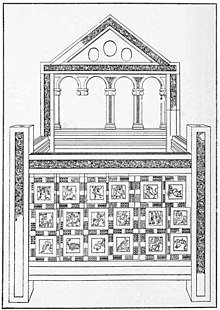這是the naked truth 的"翻譯"
不過,此處的Naked,意思不是"裸體的",而是"公開的、不掩飾的":
(Especially of feelings or behaviour) expressed openly; undisguised:
Others called her “Truth”, since it is said that “the truth is naked.”
Gloria in excelsis Deo ( L. ):天主在天受光榮:彌撒中光榮頌的首句,又稱大榮福頌。同 angelic hymn ;參閱 doxology 。
Gloria Patri ( L. ):願光榮歸於父:聖三光榮頌之首句,全頌譯為:「願光榮歸於父,及子及聖神,起初如何,今日亦然,直到永遠。阿們。」。參閱 doxology 。
Glorious Mysteries :(玫瑰經的)榮福奧跡;榮福五端:五端為:耶穌復活、耶穌升天、聖神降臨、聖母蒙召升天、聖母加冕為母后。參閱 corona 。
The Chair of Saint Peter (Latin: Cathedra Petri), also known as the Throne of Saint Peter, is a relic conserved in St. Peter's Basilica in Vatican City, the sovereign enclave of the Pope inside Rome, Italy. The relic is a wooden throne that belongs to the Apostle Saint Peter, the leader of the Early Christians in Rome and first Pope, used as Bishop of Rome.[1] The relic is enclosed in a sculpted gilt bronze casing designed by Gian Lorenzo Bernini and executed between 1647 and 1653.[1] In 2012, Pope Benedict XVI described the chair as "a symbol of the special mission of Peter and his Successors to tend Christ’s flock, keeping it united in faith and in charity."[2]
The wooden throne was a gift from Emperor of the Romans Charles the Bald to Pope John VIII in 875.[1] It has been studied many times over the years, the last being from 1968 to 1974, when it was last removed from the Bernini altar.[3] That study concluded that it was not a double, but rather a single, chair with a covering and that no part of the chair dated earlier than the sixth century.[3]
| Chair of Saint Peter | |
|---|---|
| Latin: Cathedra Petri | |
 | |
| Artist | Gian Lorenzo Bernini |
| Year | 1657–1666 |
| Catalogue | 61 |
| Type | Sculpture |
| Medium | Gilt bronze |
| Location | St. Peter's Basilica, Vatican City |

沒有留言:
張貼留言